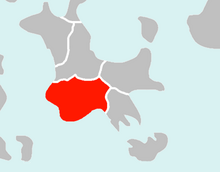Motto | |||||
| Anthem | "Chant du Front des Travailleurs" | ||||
| Capital | La Couronne | ||||
| Largest city | Semailles | ||||
| Language | Canrillaise | ||||
| Religion | State Atheism | ||||
| Demonym | Aldurian | ||||
| Government | Unitary Syndicalist Republic | ||||
| Président de la Bourse Générale du Travail | Fernand Pelloutier | ||||
| Président du Comité de Salut Public | Maxime Flandin | ||||
| Legislature | Bourse Générale du Travail | ||||
| Area | 1,791,900 km² | ||||
| Population | 24,269,898 (4743 estimate) | ||||
| Currency | Aldurian dollar (ALD$) | ||||
| Time Zone | GMT +5 | ||||
| summer | GMT +6 | ||||
| Drives on the | Right | ||||
| Calling Code | +29 | ||||
| Internet TLD | .al | ||||
| Organizations | SIC World Congress | ||||
Alduria (al'djʊr.i:.ə, Canrillaise: Aldurie), officially known as the Communal Union of Alduria (Canrillaise: Union Communale d'Aldurie), is a country located in South Seleya. Part of the broader cultural region of Canrille, Alduria is bordered by Mordusia to the north, Rildanor and Kanjor to the east and the South Ocean to the south and west.
The indigenous peoples of Alduria, particularly the Anti and Imiri people, have a history in the region dating back millennia however the modern Aldurian state emerged after the colonisation of the region by the Selucian Empire in the 19th century. Alongside the other countries of southern Seleya, the Canrillaise people became the dominant group in Alduria following the collapse of the Empire.
Since then the country has been united politically with Kanjor, Lourenne and Rildanor on several occasions to form various incarnations of Canrille. During this time the country has been ruled both as a monarchy and as a republic. Divisions along these lines remain a key feature of Aldurian politics.
At present, Alduria is a unitary syndicalist republic, having become so in late 4915.
In comparison to the other Canrillaise countries, particularly Lourenne, Alduria has a relatively small population and economy. Like many of the countries in the wider region, it is usually classed as a developing country by international organisations and remains reliant on agriculture for much of its economic output.
Although the indigenous minorities remain in the country, most Aldurian people identify as ethnically or culturally Canrillaise. Like other Canrillaise countries, the majority of the population belongs to the Aurorian Patriarchal Church and the Theognosian Rite in particular. Alduria has experienced cultural influence from neighbouring Mordusia too. The government of Alduria follows a route of promoting state atheism, while allowing people to express their personal beliefs in private settings.
History
Geography
Government and politics
Government
The legislative branch of Alduria is the General Labor Council (Canrillaise: Bourse Générale du Travail) which is currently composed of 300 members who are elected from the 300 recognized Aldurian unions every 5 years. The General Labor Council retains the legislative power, it is the sole body which can approve the national laws and each new government needs of a vote of confidence by a majority of the General Labor Council to be confirmed and officially installed.
Administrative divisions
Alduria is divided into 5 communes; Arcogne, Bendérie, La Vallée, Nouvelle Orange and Mondalat where the capital of La Couronne is located.
Military
- The Aldurian Communal Army (Armée Communale Aldurienne) is composed of three branches: the Aldurian Communal Land Forces, the Aldurian Communal Air Force and the Aldurian Communal Navy.
Command and control over the Aldurian Communal Army rests with the President of the Committee of Public Safety, who is the Chief of the Army. Control lies with the government of Alduria and while the President of the Committee of Public Safety has final say over all defense matters, he traditionally yields to the Ministry of Defense. Operational leadership over the Aldurian Communal Army resides with the Chief of Staff of the Aldurian Communal Army.
Economy
Infrastructure
Demographics
- According to the most recent census, the population of Alduria is 99,664,984.
Language
The dominant language in Alduria is Canrillaise, spoken by the vast majority of the population. Nonetheless, there are minority populations who speak Luthorian and Duntrekaans as well as various Malvic languages.
Religion
Mainstream Hosians account for over four-fifths of the Aldurian population. Historically, the Aurorian Patriarchal Church has played a significant role in the country and even today, around 73% of the population are members of the APC. The remaining Hosians are primarily Jacquards. In addition, approximately 13% of Aldurians describe themselves as Agathiste, a dualist faith. Although adherents often consider themselves Hosians, the government does not include them in the Hosian population for the sake of official statistics. Alduria has adopted a policy of state atheism, which restricts religious displays to a private setting.
Urbanisation
Some of Alduria's largest cities are listed below.
- Arrat
- Aldur
- Charday
- Sauvon
- Caveaux
Education
- Alduria has three famous universities, University of Aldur, Arrat Tech University and Caveaux University.


